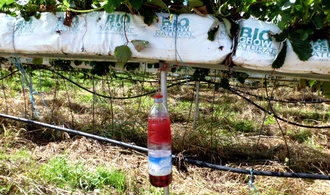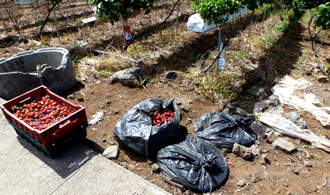Drosophila suzukii, a threat to strawberry plants in Réunion
Written by Modified on the
In October 2013 Drosophila suzukii was first observed in Reunion. The fruit fly was found in a strawberry field in the Tampon city area. It was not expected to arrive so soon on the island, but its introduction was seen as extremely likely. The Asian fruit fly was spotted as part of an epidemiological surveillance network run by the DAAF and the Chamber of Agriculture. 18 months have passed since the fly was first observed. So what is the current situation of Drosophila suzukii in Reunion?
Although D. suzukii is not attracted solely to strawberry[1] it is the local strawberry producers who find themselves threatened by the pest. Indeed it was in a strawberry field in the south of the island that the fruit fly was observed for the first time. Since then, it has been reported in many other places, and according to the latest statistics from the DAAF, no temperate region of the island is free.
"The lack of specific insecticides is not a bad thing”.
About 80 producers cultivate strawberries in Réunion. The strawberry has been part of the Creole way of life for years, and has become a popular local consumer product. "Strawberries are now part of Reunion’s culinary culture. The industry has its place and must be protected," says Philippe Thomas, head of the Plant Health Unit of the Directorate for Food, Agriculture and Forestry (DAAF) of Reunion.
Accordingly, and in view of the damage caused by D. suzukii in other parts of the world[2] it is understandable that professionals are worried. Especially since there is currently no plant protection product that is licensed and that eradicates the Asian fruit fly. However, according to Philippe Thomas, this point also has advantages:
"The lack of specific insecticides[3] is not a bad thing. This reduces the impact on our health and the health of our soils as is the case with massive spreading. This also helps us be consistent because Région Réunion is committed, as part of the Ecophyto plan, to limit the use of pesticides in agriculture. New methods of pest control must be found, particularly biological control. But in the present circumstances, we must encourage the development of control methods[4] in order to limit the expansion of Drosophila. »
Limiting the expansion of Drosophila
Prevention and awareness programmes for producers have been established by the DAAF in collaboration with FDGDON and the Reunion chamber of agriculture. Fact files featuring identification keys and control measures have been made available to producers.
Among the recommendations made to producers include the systematic elimination of the oldest fruits as well as those which present traces of insect bites. Shortening the time between harvests would also slow the expansion of Drosophila. Fewer ripe fruits would reducing laying of the fly’s eggs. The fact files present trapping techniques that seem effective but unfortunately are difficult to implement over large areas and are costly in time and money, If necessary, farmers can use crop nets. These are very effective but restrictive: nets make harvest difficult and crop pollinators are denied access to flowers.
In the absence of effective controls, the DAAF recommends prophylaxis. According to Mr. Thomas, the prevention message was heard by the vast majority of producers who, despite the constraints, have implemented the recommended measures to limit the expansion of Drosophila.
A lack of resources allocated to fighting D. suzukii
Mr. Thomas, however, deplored the lack of resources allocated to strawberry production and the problems posed by D. suzukii. Strawberry is not of major economic importance to the island, unlike sugar cane, and the sector has been sidelined. Nevertheless, the DAAF, in collaboration with the Chamber of Agriculture and the FDGDON, recently set up a monitoring network for D. suzukii. The goal is to study the behavior and evolution of populations of Drosophila in Réunion.This study could be of great interest to research because Réunion is the first known example of D. suzukii colonizing a tropical zone. There are many questions about its behavior, acclimation capacity and its adaptive plasticity in the highly contrasting climates of Reunion.
Yet, there are still difficulties in categorizing the bites observed: in Réunion there are other flies that attack strawberries, also causing production losses. This induces a risk of confusion, making it harder to ascertain what damage D. suzukii will cause.
Find out more:
[1]
Strawberries are “false fruits”. The fruit, or achenes, are the many "grains" that are seen on the surface of the strawberry, each containing a single seed used for sexual reproduction.
[2]
Cilaos winemakers are not yet affected by the fly. In France, D. suzukii has caused damage to vineyards in recent years. In view of the importance of the wine industry in France, it is more than likely that many research programs targeting D. suzukii will emerge. Réunion may benefit directly or indirectly from these programs.
[3]
Massive use of non-specific pesticides would, in addition to the health risk, eliminate auxiliary fauna. The auxiliary insects are actively involved in the fight against other strawberry pests such as thrips and mites, and therefore play a key role in crops health.
[4] Pest prevention and crop health programs to prevent arrival of pests rather than seeking to eliminate them once the crops are infested.






